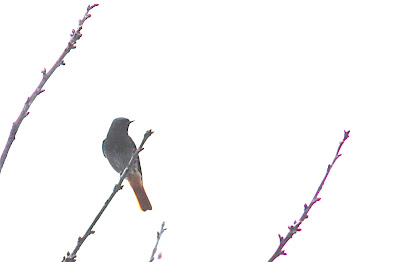With a day off, I headed down the LDV to look for spring migrants. A couple of singing Chiffchaffs heralded my arrival at North Duffield Carrs. Oystercatchers and Curlews were flying about noisily, adding to the songs of Skylarks and Reed Buntings. Otherwise, it felt like late winter, with plenty of wildfowl and wintering waders on the ings. Nearby, 253 Whooper Swans in the fields were a mix of the LDV herd and others from further south that were starting to head north. Round at Aughton, 26 Dunlins and 12 Ruff were feeding in the shallow water. On to East Cottingwith, where about 80 Black-tailed Godwits were flying about, but besides a couple more singing Chiffchaffs there was not much else in the way of migrants.
News of yesterday's Alpine Swift still being present at Easington was too big a temptation for my increasingly-fanatical swift tendencies, so I made a rare journey Spurn-wards. The last message I had was the bird was drifting south, so I headed to the southside of the village and parked by the beach, to scan. Nothing to the south, I then looked back north and almost instantly picked up the shape of the large swift carving across the sky above the gas site. Heading back round, I parked near Dimlington and walked down the coastal strip, between the beach and the terminal, immediately spying the crescent shape zipping about over the works. To my surprise the only two birders already there were leaving, so I had this amazing Alpine visitor to myself!
In gloomy skies, the bird was attracted to the insects gathering around the warmth of the gasworks, zooming back and forwards with barely a flap. After a while, the sun began to peep through and the air noticeably warmed. The Alpine Swift changed its circuit and drifted more over my head and started feeding over the sea, bringing it in range of my little camera. Alpine Swifts are absolutely cosmic birds and to get views like this was incredible. The white throat patch was characteristically unobvious compared with the big white square belly patch, but the overall size and deeper wingbeats (when it actually beat it's wings, which was rare!) were eye-catchingly distinctive.
Increasing cloud-cover saw the swift return to patrolling over the gas site buildings. Some of the workers noticed their visitor and must have had amazing views from up on the scaffolding; they gave me the thumbs up!Top photo shows the swift homing in on a hapless insect
I suddenly noticed I had been mesmerised by this bird for nearly two hours and it was time to head west.I hope this bird makes a safe return to its breeding grounds. It is part of the biggest ever influx of Alpine Swifts into the UK, on the back of a strong southwesterly airflow out of Iberia, which must have swept birds northwards as they returned from Africa. These birds are capable of incredible flights and as long as the weather remains benign they should be ok and find their way back to their breeding grounds far to the south. It is quite something to note that the last swift I saw last year was York's first Pallid Swift, and the first swift of 2023 is an Alpine Swift here in Yorkshire!
....
Heading home, I received a message that a Redstart had been seen in Bishopthorpe. With the time of year being too early for Common Redstarts, and the fact the bird was zipping around the rooftops of local bungalows, it would undoubtedly prove to be a Black Redstart. Paul Brook, who had messaged me, checked it out and found the bird - a cracking male Black Red. I pulled in there on my way back and within a few minutes saw this bird, which was one of the best adult males I have seen, with jet black plumage and a bright white wingflash. They are pretty rare in the York area, so this was a real treat and literally a stone's throw from my house. So near, yet so far from my garden list!















No comments:
Post a Comment